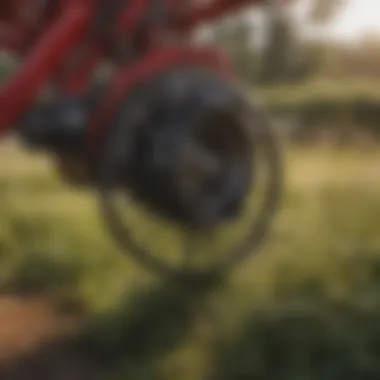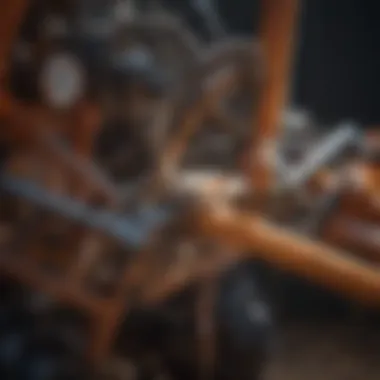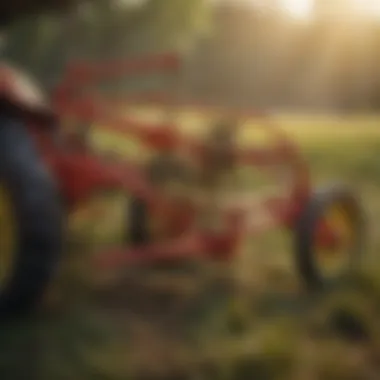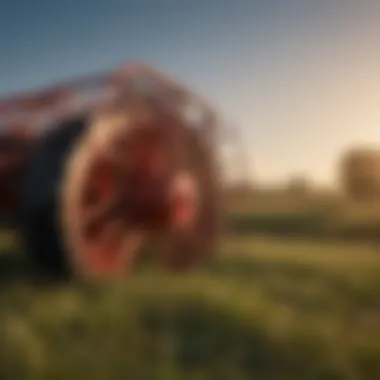Understanding Hay Tedder Parts for Efficient Farming


Intro
Hay tedders serve a fundamental role in the processes of forage harvesting and hay production. Understanding the various components of these machines becomes crucial for farmers aiming to maximize their efficiency and productivity. Each part of the hay tedder contributes to its overall function, from the tine wheels to the frame.
Grasping how these components work together not only enhances operational effectiveness but also aids in the maintenance and longevity of the equipment. As technology in agriculture evolves, so too do the designs and functionalities of hay tedders, making it essential to keep abreast of innovations in this area.
Overview of the Topic
Definition and Importance
A hay tedder is an essential tool used in the handling of hay. Its primary function is to spread out freshly cut grass or hay to promote faster drying. This is vital as moisture content directly impacts the quality of the forage. Timely drying helps reduce losses from weather or spoilage, ultimately improving the yield for farmers.
Moreover, the effective use of a hay tedder can significantly enhance the overall efficiency of forage production. Understanding the specific parts can lead to targeted maintenance, reducing downtime and repair costs. Farmers can optimize their use by understanding the mechanics behind each function, ensuring they are getting the most out of their equipment.
Current Trends
Recent advancements in hay tedder technology have introduced features such as enhanced adjustment systems for tines and improved gear mechanisms. These modifications aim to simplify operation and improve efficiency. Additionally, the trend towards more environmentally sustainable practices has led to designs that minimize soil compaction and promote better soil health.
By recognizing these trends, farmers can make informed decisions about their equipment needs. This adaptability to technological advancements not only improves current practices but also prepares farmers for future innovations.
Key Techniques and Practices
Step-by-Step Guide
- Select the Right Hay Tedder: Understand the size of your operation and choose accordingly.
- Regular Inspection: Inspect all parts routinely for wear and tear to prevent mechanical failure.
- Adjust Settings: Ensure that the tines are set to the correct height for optimal performance.
- Monitor Weather Conditions: Keep an eye on weather patterns to determine the best time to ted.
- Routine Maintenance: Follow a maintenance schedule to extend the lifespan of the equipment.
Tools and Equipment Needed
- Basic Hand Tools: Pliers, wrenches, and screwdrivers for adjustments and repairs.
- Lubricants: Regularly lubricate moving parts to maintain functionality.
- Replacement Parts: Keep a kit with essential spares for swift repairs.
Challenges and Solutions
Common Obstacles
Farmers often face issues such as tine damage, improper adjustments, and maintenance neglect. Each of these problems can lead to reduced efficiency and increased costs.
Innovative Solutions
Implementing systematic maintenance checklists can help prevent many common issues. Investing in higher-quality tines and components can also reduce wear and extend usage. Education and training on the correct operation of hay tedders will further support optimal use.
"A well-maintained hay tedder ensures the quality of hay, directly impacting livestock nutrition."
By understanding both the mechanisms and maintenance needs of hay tedders, farmers can significantly augment their productivity while reducing operational costs.
Preamble to Hay Tedders
In the world of agriculture, the importance of hay tedders cannot be overstated. These machines play a crucial role in the hay-making process, allowing for more efficient drying of grass and legumes, which ultimately enhances both quality and yield. By understanding hay tedders, farmers and agricultural professionals can make better decisions regarding their usage, maintenance, and optimization.
The primary function of a hay tedder is to aerate the cut grass, promoting faster drying and preventing spoilage. This is essential because the moisture content of hay directly affects its nutritional value and shelf life. Farmers who employ efficient hay tedding strategies can often produce hay that is of higher quality, which translates to better livestock health and productivity.
Moreover, the operations of hay tedders have evolved with advancements in technology. Modern machines are designed not only for efficiency but also for operator comfort and safety. Understanding the mechanisms behind these machines allows farmers to maximize their investment and enhance overall productivity.
As we delve deeper into the components and operational mechanisms of hay tedders, key insights will emerge to highlight their significance in modern agriculture.
Significance of Hay Tedding in Agriculture
Hay tedding is a critical practice in agriculture, particularly in areas where livestock farming is prevalent. The process of tedding affects multiple aspects including:
- Quality of Hay: Effective tedding reduces the drying time, leading to better preservation of nutrients.
- Increased Productivity: Quick turnover from field to storage allows for a more efficient farming operation overall.
- Reduced Spoilage Risks: Bad weather can impact the cutting of hay; effective tedding minimizes risks associated with moisture retention, leading to healthier fodder.


Understanding why hay tedding is significant helps in appreciating the nuanced details of hay tedder parts and their roles within this process.
Overview of Hay Tedder Mechanisms
The mechanisms of a hay tedder are designed with precision to ensure optimal operation and efficiency. Generally, the machines consist of several key components that work together. Some of these include:
- Rotors: These are the moving parts that lift and spread out the hay.
- Tines: Attached to the rotors, tines are what actually grab and flip the hay, allowing air circulation for drying.
- Gearbox: This component transmits power to the rotors, ensuring they function correctly.
- Frame: The structure holds all components together and must be robust enough to withstand the rigors of fieldwork.
An understanding of these mechanisms not only aids in better operational practices but also helps in maintenance and troubleshooting. Farmers who are knowledgeable about their equipment often achieve more success in their hay production endeavors.
Key Components of Hay Tedders
Understanding the key components of hay tedders is crucial for both operational efficiency and productivity in agriculture. Each part works together to ensure optimal performance, contributing to the effective drying and conditioning of hay. The proper functioning of these components can significantly impact the overall productivity of the farmer's operations. A detailed analysis of these parts underscores their significance in enhancing the functionality of the hay tedder itself, and improving its reliability.
Overview of Major Parts
Hay tedders consist of various major parts that collectively determine their effectiveness. These include rotors, tines, gearboxes, and the frame structure. Each element has a distinctive role:
- Rotors: These are responsible for spreading out the hay, allowing for improved air circulation, which fosters quicker drying.
- Tines: Attached to the rotors, tines rake and lift the hay, preventing it from matting together.
- Gearbox Assembly: The gearbox connects the power source to the mechanical components, driving the entire system mechanically.
- Frame Structure: This part provides the stability needed for the machine to operate without twisting or breaking under field conditions.
Each of these parts needs to work cohesively to achieve the best results in hay tedding.
Rotors and Tines
Functions of Rotors
The function of rotors is to facilitate the spreading of hay across the field. They turn quickly and allow a uniform distribution. This characteristic is vital as it prevents the hay from clumping, allowing sunlight and wind to reach all areas. The rotor design enhances productivity by ensuring that the hay dries evenly. A popular choice in this context is the use of adjustable rotors that can be modified based on the type of crop and environmental conditions.
Types of Tines
The types of tines used in hay tedders can vary, each offering unique benefits. Most commonly, there are standard tines and heavy-duty tines. Standard tines are lightweight and suitable for soft hay, while heavy-duty tines are made for rugged crops. This distinction is important, as using the right type can enhance the efficiency of the hopping process, ensuring quality hay is achieved.
Materials Used in Tines
The materials used for tines significantly affect their performance and durability. Tines are often constructed from spring steel or composite materials that can withstand wear and provide flexibility. Spring steel is favored due to its endurance in tough conditions, while composites may offer lighter weight. Each material has its benefits and drawbacks, making it essential for users to choose based on their specific demands.
Gearbox Assembly
Role of Gearbox in Operation
The gearbox is crucial for the proper operation of hay tedders. It translates the engine's power into rotational motion needed for the rotors. A well-functioning gearbox can enhance efficiency and maintain consistent performance. Its design often includes multiple gears, allowing for variations in speed and torque, which can be essential when working in different field conditions.
Types of Gearbox Configurations
Different types of gearbox configurations provide various operational advantages. A common configuration is the direct drive, which has fewer moving parts and is often easier to maintain. Other configurations, like the chain drive, offer flexibility in gear ratios. Each type has its unique features, contributing differently to the performance of the hay tedder.
Frame Structure
Importance of Structural Integrity
The structural integrity of the frame is paramount for the durability of hay tedders. A robust frame can withstand the rigorous conditions of agricultural work. This includes handling the stress from intensive field use, especially in uneven terrain. A well-designed frame contributes to better stability and safer operations.
Materials and Design Choices
Materials and design choices for the frame can affect weight and durability. Heavy-duty steel is commonly used for its strength, but aluminum frames are becoming more popular due to their lighter weight. The design might also include features like reinforced joints to enhance lifespan. Each option presents trade-offs between weight and strength that can impact performance and ease of use.
Operational Efficiency of Hay Tedders
The operational efficiency of hay tedders is a critical factor in optimizing the process of converting grass into dry hay. Hay tedding, as a practice, is designed to enhance the drying process and improve the quality of the forage. This article discusses the various elements that contribute to the efficiency of hay tedders, emphasizing adjustments that can maximize productivity.


Adjusting Tedding Height
One factor that greatly influences the efficiency of hay tedders is the ability to adjust tedding height. Proper height adjustment allows for better air circulation around the hay, facilitating faster drying times. When the tedding height is set too low, it risks damaging the grass, which can result in a decrease in yield and nutritional value. Conversely, if set too high, it may not effectively spread the crop, leading to uneven drying.
Farmers need to find a middle ground based on the type of forage and environmental conditions. A well-adjusted tedder can significantly reduce the time and effort needed for hay preparation. Farmers often note improved results by making small, precise adjustments during operation.
Speed Parameters
Speed parameters are another important aspect of hay tedder operation. The speed at which a tedder operates directly correlates to its effectiveness. Higher speeds may cover more ground quickly but can lead to the risk of fluffing or causing the grass to windrow improperly. On the other hand, slower speeds may achieve more even coverage but could extend the duration of the tedding process.
Farmers often evaluate their unique circumstances, such as the density of the crop and soil conditions, to determine the optimum speed. It is crucial to balance coverage and efficiency to maximize productivity without compromising quality.
Transportation Features
The transportation features of hay tedders contribute significantly to their operational efficiency. This involves three main aspects: folding mechanisms, towability, and compatibility with other farm equipment. Each of these elements plays a role in how efficient the tedder is, not just in the field but during transport to and from job sites.
Folding Mechanisms
Folding mechanisms in hay tedders allow for more compact storage and easier transport. They enable the machine to reduce its width when moving on public roads, which is essential for compliance with transport regulations. A well-designed folding mechanism is easy to operate, ensuring that farmers can spend less time adjusting equipment and more time on the task.
The key characteristic of effective folding mechanisms is that they do not compromise the machine's stability or performance during operation. This unique feature can contribute to safety during transport and ease of use in the field, making it a beneficial aspect of modern hay tedder design.
Towability and Compatibility
Towability and compatibility are vital in ensuring that hay tedders can be effectively paired with various tractors or other vehicles. A tedder that can be easily towed ensures that farmers can transport their equipment across different terrains without difficulty. The compatibility with different towing vehicles simplifies the operational process, as challenges in hitching different machines can lead to downtime.
The main advantage of an easily towable hay tedder is its versatility, allowing farmers to adapt to various towing situations or switch vehicles as needed. However, it is important to ensure the weight and balance of the tedder are compatible with the towing vehicle to prevent performance issues.
Investing in hay tedders with these efficient transportation features can reduce operational downtime and streamline workflow in agricultural operations.
In summary, understanding these operational efficiencies can lead to better decision-making in managing hay tedding. By focusing on proper height adjustment, appropriate speed parameters, and effective transportation features, farmers can improve both productivity and the quality of their hay.
Maintenance of Hay Tedder Parts
Maintaining hay tedder parts is crucial for ensuring optimal performance, durability, and efficiency in agricultural operations. Hay tedders, as machines, face significant wear and tear during their operation. Maintenance not only prevents costly repairs and replacements but also enhances the overall productivity of the machine. With regular upkeep, farmers can realize greater yields and avoid disruptions during critical harvesting periods. Thus, understanding maintenance processes is fundamental for any operator who relies on these machines.
Regular Inspection Procedures
Regular inspections allow farmers to identify potential issues before they escalate. Checking the machine periodically for loose components, rust, or signs of damage can save time and resources in long term. Inspect the rotors and tines for proper alignment and intactness. The gearbox should also be inspected to ensure there are no leaks. Timely identification of problems can lead to preventative measures that maintain machine function.
Lubrication and Deterioration
Importance of Lubrication
Lubrication plays a significant role in maintaining the functionality of hay tedder parts. Proper lubrication reduces friction between moving parts, helping to prevent overheating and wear. Lubrication is essential for prolonging the life of bearings, gears, and chains. Regular application of high-quality grease or oil helps in maintaining smooth operations, ensuring that the machine can perform efficiently for extended periods.
Signs of Part Wear and Tear
Detecting signs of wear and tear is critical for keeping hay tedders in optimal working condition. Look for unusual noises, vibrations, or decreased performance while the machine is operating. Irregularities in the operation often signify that parts may need repair or replacement. By paying attention to these signs, farmers can address issues promptly, preventing further damage that could lead to extensive downtime or increased costs.
Storage Considerations
Proper storage of hay tedders can make a significant difference in the longevity of the machine. Exposure to harsh weather conditions can lead to rust, corrosion, and other forms of deterioration. Thus, understanding best practices during storage is essential for preserving equipment.
Best Practices in Storage
Storing hay tedders in a dry, sheltered location can protect them from environmental damage. Covering machines with tarps or in a shed can minimize exposure to moisture and sunlight. Regularly cleaning the machine before storage helps remove any residue that could cause corrosion. Proper maintenance during the off-season reinforces the longevity of the parts.
Seasonal Preparations


Preparing hay tedders for seasonal changes is important for their performance. Before and after the hay season, conducting a thorough check of all components is advisable. Addressing maintenance prior to using the machine each season can prevent accidents or failures. Additionally, cleaning the machine thoroughly after the season is vital to removing debris that may affect its function.
Regular maintenance and careful storage are integral in prolonging the lifespan and efficiency of hay tedders.
Innovations in Hay Tedder Design
Innovations in hay tedder design play a crucial role in modern agriculture. As the need for improved efficiency and productivity becomes increasingly prominent, tedders have undergone significant transformations. These innovations do not only enhance operational performance but also contribute to better environmental outcomes. By understanding these advancements, farmers and agricultural professionals can make informed decisions about the equipment they use.
Technological Advancements
Automation in Hay Tedding
Automation in hay tedding focuses on reducing the physical labor required during the tedding process. This aspect is vital in enhancing productivity on the farm. Automated systems can adjust operating parameters based on real-time data, leading to optimal tedding performance. A key characteristic of this automation is its capacity to work continuously without the need for constant human oversight. This can be particularly beneficial for large-scale operations where time and efficiency are of the essence.
However, implementing such systems can have mixed effects. The upfront cost can be a deterring factor for some farmers. Additionally, not all areas may benefit equally from automated tedders, as varying agricultural practices require different approaches. Balancing costs against efficiency gains is important in the decision-making process.
Integration of Smart Technology
Integration of smart technology in hay tedders is another significant aspect driving recent design changes. This includes the use of sensors and data analytics to monitor and optimize the tedding process. One distinctive feature of this integration is its ability to provide real-time feedback, allowing for immediate adjustments to be made during tedding operations. This adaptability helps in achieving a more consistent result across different field conditions.
The integration of smart technology is beneficial for several reasons. It assists farmers in making data-driven decisions, optimizing resource usage, and potentially increasing yield. However, the reliance on technology can pose challenges, especially for those less familiar with its operation. Moreover, any technical failures could disrupt productivity if not managed properly.
Sustainability Trends
Material Innovations
Material innovations have become essential within hay tedder design. These innovations focus on utilizing lighter, more durable materials that can withstand harsh agricultural environments without unnecessary weight. A key characteristic of these materials is their ability to reduce wear and tear while improving fuel efficiency.
Using advanced materials is a popular choice since they enhance the longevity of the equipment. However, these newer materials can also be more expensive. Farmers must evaluate the long-term benefits against the initial investment. Overall, material innovations promote a more sustainable approach to agricultural machinery.
Efficiency and Environmental Impact
The relationship between efficiency and environmental impact is becoming more significant in agricultural practices, including hay tedding. Greater efficiency in tedding operations means reduced fuel consumption and lower greenhouse gas emissions. This results in economic savings while also aligning with sustainability goals.
A highlighted aspect is the development of designs that facilitate a more uniform dispersal of hay. This improves drying times and reduces the likelihood of spoilage, thus having a positive environmental impact. However, achieving these efficiencies often requires careful planning and investment. Balancing operational efficiency with environmental considerations is a challenging yet necessary undertaking for today’s farmers.
"Adopting innovative designs not only improves hay tedding efficiency but also paves the way for sustainable agricultural practices."
In summary, innovations in hay tedder design encompass both technological advancements and sustainability trends. Recognizing the implications of these innovations can assist agricultural professionals in enhancing productivity while protecting the environment.
Epilogue
In this article, the significance of hay tedders and their various components has been thoroughly examined. Understanding these parts is essential for optimizing their usage in agricultural practices. Hay tedders play a crucial role in the process of hay-making, influencing not just the quality of the hay, but also the efficiency of the operation itself. By grasping the intricate workings of tedders, farmers can enhance productivity and ensure better management of their resources.
A clear grasp of each component—such as rotors, tines, and gearbox assemblies—leads to improved decision-making. When farmers know how each part functions, they can keep equipment maintenance on track, leading to less downtime and more effective operations. The benefits of understanding tedders extend beyond immediate functionality; they contribute to the long-term viability and sustainability of farming practices.
"In agriculture, knowledge is as important as the tools we use."
Recognizing the innovations in hay tedder design also positions farmers to adopt new technologies that might further improve crop yield and sustainability. By harnessing advancements, such as automation and smart technology, the future of hay tedding can bring about more efficient farming methods. It is evident that remaining informed is imperative. As developments occur within machinery and agricultural practices, staying aware fosters adaptability.
In summary, knowledge of hay tedder parts is indispensable. As this article illustrates, a comprehensive understanding will bolster operational efficiency and lay the groundwork for the next generation of agricultural advancements.
Recap of Key Insights
Throughout this article, key insights regarding hay tedder parts were presented clearly. The discussion highlighted essential components, their functions, and the critical role they play in hay production. Several important points emerged:
- Components Matter: Every part, from rotors to the gearbox, directly affects performance.
- Efficiency is Key: Proper adjustments for height and speed can optimize operations.
- Maintenance is Essential: Regular inspection and lubrication prevent costly repairs.
- Innovations are Coming: New technologies promise to revolutionize hay tedding practices.
Each of these insights contributes to a broader understanding of how to successfully implement and maintain hay tedders.
Future Perspectives in Hay Tedding
The future of hay tedding looks promising, with emerging trends shaped by technology and sustainability. As agricultural demands grow, several future perspectives can be expected:
- Smart Technology Integration: Incorporating sensors and automated systems into hay tedders will enhance precision and operational control.
- Sustainable Materials: The trend towards eco-friendly materials in construction will continue evolving. This not only contributes to sustainability but also enhances the durability of equipment.
- Increased Efficiency: Continued research into better design and mechanization will likely yield tedders that can work faster and more effectively over larger areas.
- Data-Driven Decisions: As farming becomes more data-oriented, enhanced analytics will give farmers insights into optimal usage and performance metrics for hay tedders.



